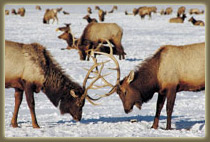The Big Horn National Forest is 80 miles long and 30 miles wide, covering over 1.1 million acres with elevations that range from 5,500 feet to 13, 175 feet and over 1500 miles of trails that make for pure riding heaven.
The Big Horn River, flowing along the west side of the forest, was first named by American Indians due to the great herds of Bighorn Sheep at it's mouth. Lewis and Clark transferred the name to the mountain range in the early 1800's.

The Bighorn National Forest, including the Cloud Peak Wilderness area, is unique and diverse. Within the National Forest area, you encounter grass prairies, evergreen forests, mountain meadows, rugged alpine peaks, dramatic canyons, arid desert lands and cascading waterfalls -- all within a day's journey.
There are several scenic byways which pass through the Bighorn National Forest, all of which provide the traveler with scenic driving. The Bighorn Scenic Byway (US 14) connects the cities of Sheridan and Greybull and includes 45 miles of scenic mountain driving. The Cloud Peak Skyway (US 16), connecting the city of Buffalo and the town of Tensleep, crosses the southern Bighorn National Forest and offers breathtaking views of snow-capped peaks along its 45 mile length. The Medicine Wheel Passage (US 14A) rises sharply from the Bighorn Basin near the city of Lovell and travels 25 miles through high alpine meadows to Burgess Junction, where it intersects with the Bighorn Scenic Byway. This route also boasts the largest ancient Medicine Wheel site in North America.
For lodging and overnight stays, please call: (307) 765-2080
or e-mail info@thehideout.com



















